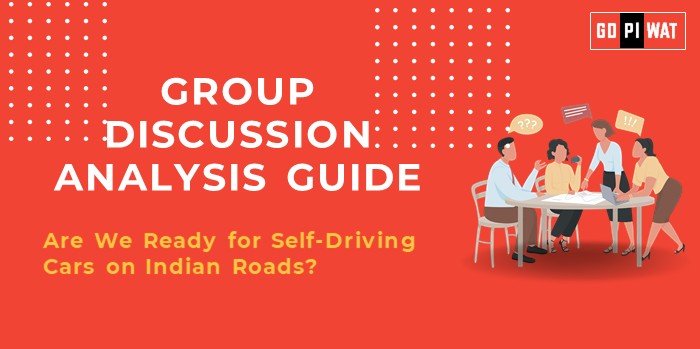📋 Group Discussion Analysis Guide: Are We Ready for Self-Driving Cars on Indian Roads?
🌐 Introduction to Self-Driving Cars on Indian Roads
Opening Context: Self-driving cars are transforming global transportation, with companies like Tesla, Waymo, and Baidu leading the race in autonomous vehicle technology. But in India, unique challenges—ranging from unstructured traffic to infrastructure readiness—pose the question: Is the country prepared to embrace autonomous driving?
Topic Background: Self-driving cars utilize AI, machine learning, sensors, and IoT to navigate and make decisions without human intervention. While developed countries are conducting pilot programs and implementing legislation for such vehicles, India’s adoption faces cultural, infrastructural, and regulatory hurdles.
📊 Quick Facts and Key Statistics
• Indian Traffic Fatalities: Over 150,000 annually (MoRTH, 2022) – Highlights potential safety benefits of automation.
• Internet Penetration in India: 900 million users (2024) – A robust digital backbone for connected car systems.
• Road Infrastructure Quality (Global Rank): 47th out of 59 countries (2023) – Indicates infrastructural challenges.
🌟 Stakeholders and Their Roles
- 🏛️ Government Agencies: Regulatory framework, infrastructure upgrades, R&D funding.
- 💡 Private Sector: Vehicle development, investment in AI, collaboration with government.
- 🚗 Citizens: Adoption, behavioral adaptation, and workforce upskilling.
- 🌐 Global Organizations: Technology sharing, partnerships for innovation.
🏆 Achievements and Challenges
Achievements:
- ✅ India’s EV Push: 1.2 million EV sales in 2023, creating a foundation for autonomous vehicles.
- ✅ Tech Talent Pool: Home to world-class AI and machine learning engineers.
- ✅ Digital Connectivity: UPI and IoT expansion indicate readiness for connected vehicle ecosystems.
- ✅ Global Collaborations: Pilot projects with international companies like Tesla and Ola Electric.
Challenges:
- ⚠️ Unpredictable Traffic: Heterogeneous vehicle mix, lack of lane discipline.
- ⚠️ Infrastructure Gaps: Insufficient road quality and inconsistent signage.
- ⚠️ Regulatory Hurdles: Absence of legal frameworks for liability and safety.
- ⚠️ Affordability: High initial costs make self-driving cars inaccessible for the masses.
🌍 Global Comparisons:
- 🇺🇸 Success: Waymo in the USA operates in well-mapped cities with structured traffic.
- 🇨🇳 Challenges: China’s rural areas face similar unpredictability in road usage.
📘 Case Study: India’s ADAS Deployment: Maruti Suzuki’s Level 2 automation features in select models as a stepping stone.
🗣️ Structured Arguments for Discussion
- 👍 Supporting Stance: “Self-driving cars could reduce accidents by eliminating human error, which causes 70% of road fatalities.”
- 👎 Opposing Stance: “Without addressing road infrastructure and regulatory frameworks, self-driving cars will struggle in India.”
- ⚖️ Balanced Perspective: “While promising for reducing accidents, the success of self-driving cars in India depends on parallel improvements in infrastructure and policy.”
🎯 Effective Discussion Approaches
- Opening Approaches:
- Statistical Hook: “With over 150,000 traffic deaths annually, could automation be the solution?”
- Global Comparison: “Countries like the USA are making strides with autonomous vehicles—how far behind is India?”
- Problem-Solution Framing: “What steps must India take to bridge the gap between technology and readiness?”
- Counter-Argument Handling:
- “While India’s road unpredictability is a valid concern, adaptive AI systems and targeted infrastructure upgrades can mitigate these challenges.”
📈 Strategic Analysis of Strengths and Weaknesses
- Strengths: Strong tech ecosystem, growing digital infrastructure, global partnerships.
- Weaknesses: Poor road infrastructure, lack of regulations, cultural resistance.
- Opportunities: Safety improvements, reduced congestion, AI-driven industries.
- Threats: Job displacement, hacking risks, slow policy adaptation.
🎓 Connecting with B-School Applications
- 📌 Real-World Applications: Autonomous cars link to AI innovation, supply chain management, and sustainability themes.
- ❓ Sample Interview Questions:
- “What policy changes are necessary for India to adopt self-driving cars?”
- “How can AI solve India’s road traffic issues?”
- 💡 Insights for Students:
- Focus on AI and IoT-related internships.
- Explore case studies in adaptive tech for unstructured environments.


